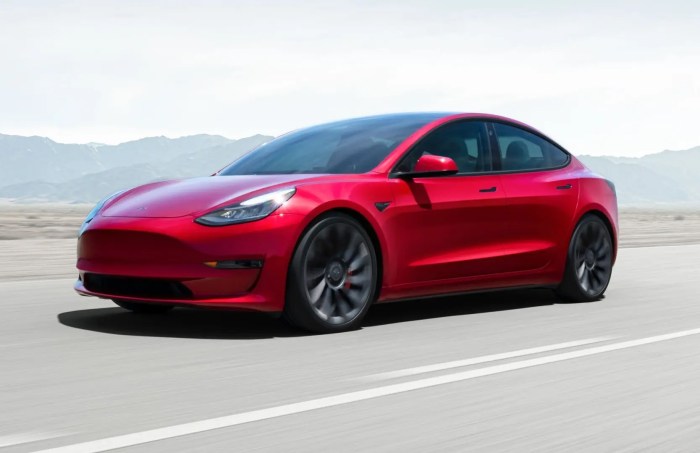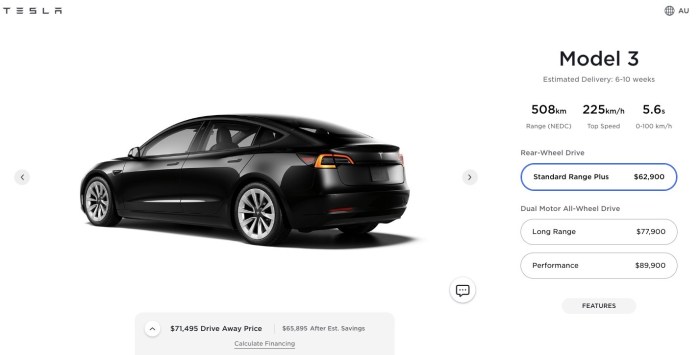Tesla New Electric Car Price A Comprehensive Overview
Tesla’s Electric Vehicle Pricing

Source: vehiclesuggest.com
Tesla new electric car price – Tesla’s pricing strategy for its electric vehicles is a complex interplay of technological advancements, manufacturing costs, market competition, and brand perception. Understanding these factors is crucial to comprehending the price points of Tesla’s offerings and predicting future trends.
Tesla’s Pricing Strategy
Tesla’s pricing decisions are influenced by several key factors. Manufacturing costs, including battery production, raw materials, and labor, are fundamental. Technological advancements, such as improvements in battery range and performance, also significantly impact pricing. Furthermore, market demand, competition from established automakers and emerging EV companies, and the overall economic climate play a role. Tesla often employs a premium pricing strategy, leveraging its brand image and technological leadership to justify higher prices compared to competitors.
This strategy, however, is subject to adjustments based on market feedback and the need to remain competitive.
Comparison with Competitors
Compared to traditional automakers, Tesla generally positions its vehicles at a higher price point, reflecting the advanced technology and performance capabilities. However, the price gap is narrowing as competitors introduce their own electric vehicles with improved features and battery technology. While some competitors focus on affordability, Tesla prioritizes performance and technological innovation, justifying the premium price tag. The comparison varies greatly depending on the specific model and features being compared.
Tesla’s Pricing Tiers and Options
Tesla typically offers different pricing tiers based on battery capacity, range, performance features, and optional extras. The base model often features a smaller battery pack and less powerful motor, while higher-tier models offer increased range, faster acceleration, and more advanced features. Additional options, such as enhanced autopilot capabilities, premium interior materials, and specialized paint colors, further increase the price.
These options allow customers to customize their vehicle to meet their specific needs and budget.
Hypothetical Pricing Structure for a New Tesla Model
Consider a hypothetical new Tesla compact SUV, the “Model Y Compact.” A base model with a smaller battery pack (offering a 250-mile range) might be priced around $40,000. A mid-range version with a larger battery (350-mile range) could be priced at $50,000. A high-performance version with all-wheel drive and enhanced acceleration could command a price of $60,000 or more.
These prices would need to be adjusted based on regional market conditions and competitive pressures.
Impact of Battery Technology on Tesla Prices
Battery technology is a pivotal factor influencing Tesla’s vehicle pricing. Advancements in battery chemistry, energy density, and manufacturing processes directly affect both manufacturing costs and vehicle performance. The trade-offs between battery range, performance, and price are significant, shaping Tesla’s pricing strategy and consumer choices.
The price of Tesla’s new electric car is a significant factor for many potential buyers, often prompting comparisons with other vehicles in similar price brackets. For those considering more affordable options, checking the skoda fabia new car price might offer a useful benchmark. Ultimately, the Tesla’s price point, while potentially higher, reflects its advanced technology and performance capabilities.
Battery Technology’s Influence on Manufacturing Costs
Improvements in battery technology, such as higher energy density, lead to reduced battery pack size and weight for the same range, thus lowering material costs and manufacturing complexity. Advances in battery chemistry also reduce the need for rare earth minerals, potentially reducing overall cost. Conversely, higher-performance batteries with faster charging capabilities might increase manufacturing costs due to more sophisticated materials and manufacturing processes.
This complex relationship necessitates careful consideration when setting vehicle prices.
Trade-offs Between Range, Performance, and Price
A longer range generally requires a larger and more expensive battery pack. Similarly, higher performance demands more powerful motors and potentially a larger battery, increasing the overall cost. Tesla often offers various battery options to cater to different consumer preferences and budgets. Customers can choose between a balance of range and performance or prioritize one over the other, impacting the final price.
Cost Components of a Tesla Battery Pack
The cost of a Tesla battery pack is comprised of several key components: the battery cells themselves (the largest portion), the battery management system (BMS), the packaging and cooling system, and the labor involved in assembly. The cost of raw materials, particularly lithium, cobalt, and nickel, fluctuates significantly and impacts the overall battery pack price. Manufacturing efficiency and economies of scale play a crucial role in reducing these costs.
Comparison of Battery Technology Across Tesla Models
| Model | Battery Technology | Approximate Range (miles) | Approximate Price (USD) |
|---|---|---|---|
| Model 3 Standard Range Plus | Lithium-ion NCA | 263 | $38,000 |
| Model Y Long Range | Lithium-ion NCA | 330 | $50,000 |
| Model S Plaid | Lithium-ion 4680 | 396 | $135,000 |
| Model X Plaid | Lithium-ion 4680 | 348 | $140,000 |
Note: Prices and ranges are approximate and can vary based on options and regional factors. The table illustrates the general trend of higher-performance models utilizing more advanced battery technology and commanding higher prices.
Consumer Perception and Tesla’s Pricing: Tesla New Electric Car Price
Consumer perception of Tesla’s pricing is influenced by several key factors, including the brand’s image, the vehicle’s features and performance, and the availability of government incentives. Addressing consumer concerns is crucial for maintaining market share and fostering customer loyalty.
Factors Influencing Consumer Perception
Tesla’s premium brand image and reputation for innovation contribute to its ability to command higher prices. Consumers often perceive Tesla vehicles as technologically superior and environmentally friendly, justifying the higher cost. However, concerns about affordability, long waiting times, and the complexity of the purchase process can negatively impact consumer perception. The perceived value proposition—the balance between price and benefits—is a crucial determinant of purchase decisions.
Impact of Tesla’s Brand Image
Tesla’s strong brand image, built on innovation and sustainability, allows it to charge premium prices. Consumers associate the brand with cutting-edge technology, high performance, and environmental consciousness. This positive brand perception translates into a willingness to pay a higher price compared to competitors. However, maintaining this image requires consistent innovation and customer satisfaction.
Effects of Government Subsidies and Tax Incentives
Government subsidies and tax incentives for electric vehicles significantly impact consumer affordability. These incentives can reduce the effective price of a Tesla, making it more competitive with gasoline-powered vehicles. The availability and magnitude of these incentives vary across different regions, influencing consumer demand and Tesla’s pricing strategies in those markets.
Consumer Concerns Regarding Tesla’s Pricing and Solutions
- High initial cost: Tesla could explore more affordable base models or financing options.
- Limited range anxiety: Continued battery technology advancements and expanded Supercharger network are key.
- Long wait times for delivery: Improved manufacturing efficiency and supply chain management are necessary.
- Complexity of the purchasing process: Simplifying the online ordering and delivery process can enhance customer experience.
Future Trends in Tesla Electric Car Pricing

Source: teslarati.com
Predicting future Tesla pricing requires considering several factors, including technological advancements, increased competition, and evolving market dynamics. Technological breakthroughs, such as solid-state batteries, have the potential to significantly alter the cost structure of electric vehicles in the coming years.
Potential Changes in Tesla’s Pricing Strategy
Over the next five years, Tesla might adopt a more diversified pricing strategy, offering a broader range of models targeting different market segments. This could involve introducing more affordable models to compete with emerging rivals or focusing on luxury features and higher price points for its flagship vehicles. The company may also leverage subscription models for certain features, generating recurring revenue streams and potentially lowering the initial vehicle cost.
Impact of Technological Advancements
Advancements in battery technology, such as the widespread adoption of solid-state batteries, are expected to reduce manufacturing costs and increase energy density. This could lead to lower vehicle prices or significantly improved range and performance at the same price point. Autonomous driving technology, while adding initial costs, may increase vehicle value in the long run, potentially impacting pricing strategies.
Influence of Increased Competition and Market Saturation
Increased competition from established automakers and new EV startups will put pressure on Tesla’s pricing power. As the market becomes more saturated, Tesla may need to adjust its pricing strategy to remain competitive, potentially offering more aggressive pricing or focusing on differentiation through unique features and brand loyalty.
Predicted Trajectory of Tesla Vehicle Prices
A text-based depiction of the predicted trajectory of Tesla vehicle prices over the next decade suggests a period of initial price stability followed by a gradual decline. This decline will be driven by advancements in battery technology and increased manufacturing efficiency. However, higher-performance models and vehicles with advanced features are likely to maintain a premium price point. The overall trend is expected to be a downward trajectory, with the rate of decline varying across different model lines.
Geographical Variations in Tesla Car Prices
Tesla vehicle prices vary significantly across different geographical regions due to several factors, including import duties, taxes, local market conditions, and currency exchange rates. Understanding these regional variations is crucial for analyzing Tesla’s global pricing strategy and market penetration.
Factors Contributing to Price Differences
Import duties and taxes imposed by different countries significantly impact the final price of Tesla vehicles. Local market conditions, including consumer demand, competition, and regulatory environments, also play a crucial role. Currency fluctuations between the US dollar (Tesla’s primary production currency) and other currencies affect the price in different regions. Additionally, transportation costs and regional distribution networks contribute to price discrepancies.
Tesla’s Pricing Strategies in Various Countries, Tesla new electric car price
Tesla often adjusts its pricing strategies in various countries to adapt to local market conditions and regulatory frameworks. This may involve offering different vehicle configurations, adjusting optional packages, or implementing localized marketing campaigns. The company also collaborates with local governments and partners to optimize distribution networks and streamline the purchase process.
Key Differences in Tesla Pricing Across Three Major Global Markets
- United States: Generally lower prices due to domestic production and lower import duties.
- Europe: Higher prices due to import duties, taxes, and regulatory compliance costs.
- China: Prices are influenced by local production costs, government incentives, and intense competition from local EV manufacturers.
User Queries
What are the typical financing options available for purchasing a Tesla?
Tesla offers various financing options, including loans through third-party lenders and leasing programs. Specific options and terms vary depending on the model, location, and customer creditworthiness.
How does Tesla’s warranty compare to other electric vehicle manufacturers?
Tesla’s warranty coverage varies by model and region. It’s advisable to check the specific warranty details for the model you are considering on Tesla’s official website.
Does Tesla offer any trade-in programs for existing vehicles?
Yes, Tesla often offers trade-in programs, allowing customers to exchange their existing vehicles for credit towards a new Tesla. The value offered for trade-ins depends on the make, model, year, and condition of the vehicle.




















